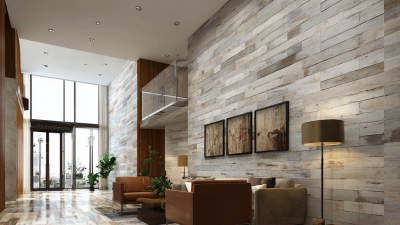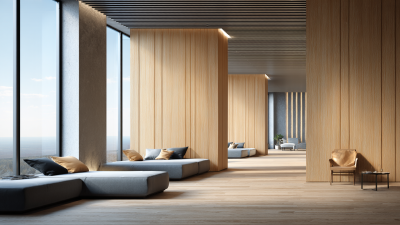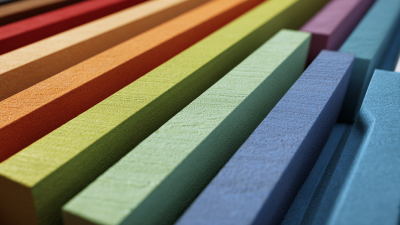Leave Your Message
In the realm of interior design, the selection of materials plays a pivotal role in shaping the aesthetic and functionality of any space. One of the most innovative materials gaining popularity is the Wpc Wall Panel Board. This versatile product combines the best qualities of wood and plastic composite, offering a durable and sustainable solution for both residential and commercial applications.
 As homeowners and designers alike seek to create unique atmospheres, the Wpc Wall Panel Board stands out for its ability to mimic the appearance of natural wood while resisting moisture and pests. In this article, we will explore inventive design ideas and practical tips for utilizing Wpc Wall Panel Board to transform your spaces into modern, stylish environments that reflect your personal taste and enhance the overall functionality of your home or office. Embrace the evolution of wall design with these creative insights and elevate your interior spaces like never before.
As homeowners and designers alike seek to create unique atmospheres, the Wpc Wall Panel Board stands out for its ability to mimic the appearance of natural wood while resisting moisture and pests. In this article, we will explore inventive design ideas and practical tips for utilizing Wpc Wall Panel Board to transform your spaces into modern, stylish environments that reflect your personal taste and enhance the overall functionality of your home or office. Embrace the evolution of wall design with these creative insights and elevate your interior spaces like never before.
 When it comes to modern interiors, WPC (Wood Plastic Composite) wall panels offer a versatile and stylish option for homeowners and designers alike. These panels not only add an element of sophistication but also provide and ease of maintenance. One innovative way to incorporate WPC wall panels is by creating accent walls. Choose a focal point in your living room or bedroom and cover it with a beautiful WPC panel design to instantly transform the space.
When it comes to modern interiors, WPC (Wood Plastic Composite) wall panels offer a versatile and stylish option for homeowners and designers alike. These panels not only add an element of sophistication but also provide and ease of maintenance. One innovative way to incorporate WPC wall panels is by creating accent walls. Choose a focal point in your living room or bedroom and cover it with a beautiful WPC panel design to instantly transform the space.
Another creative approach is to use WPC wall panels for functional spaces such as home offices or mudrooms. By integrating these panels, you can establish defined zones within your home while maintaining a cohesive aesthetic. For instance, installing WPC panels around a desk area can provide a sleek backdrop that enhances productivity and style.
Tips: When selecting WPC wall panels, consider colors and textures that complement your existing décor. Pair lighter panels with dark furniture for a striking contrast, or opt for earthy tones to create a warm atmosphere. Additionally, don't hesitate to mix and match different panel designs to add depth and interest to your interiors. Finally, ensure proper installation to maximize the longevity and performance of your WPC wall panels.
When it comes to transforming outdoor spaces, WPC (Wood-Plastic Composite) wall panels offer an innovative solution that combines durability and aesthetic appeal. These panels are perfect for creating stylish feature walls, borders, or even entire outdoor rooms. The versatility of WPC allows homeowners to match various architectural styles while ensuring longevity against the elements.
**Tips:** To achieve the best results with WPC wall panels, consider integrating natural elements like plants and lighting. Incorporating greenery not only enhances the aesthetic but also promotes a relaxing atmosphere. Additionally, strategically placed outdoor lighting can highlight the textures of your paneling, adding depth and warmth to the space during the evening hours.
Moreover, WPC wall panels can be used creatively to define spaces in an open area, such as enclosing a deck or patio, making them feel more inviting. By using different colors and textures, you can create a dynamic environment that reflects your personal style. Don’t forget to consider the maintenance needs of your outdoor design to ensure that your space remains beautiful and functional year-round.
| Design Idea | Description | Advantages | Best Use |
|---|---|---|---|
| Vertical Wall Panels | Using vertical WPC panels to create a modern accent wall. | Enhances height perception; modern aesthetic. | Living Rooms, Patios |
| Horizontal Slats | Installing horizontal WPC slats for a sleek, contemporary look. | Adds warmth; easy to install. | Fences, Decks |
| Accent Colors | Painting WPC panels in bright colors for added vibrancy. | Customizable; eye-catching. | Gardens, Outdoor Bar Areas |
| Integrated Lighting | Embedding lighting fixtures into the WPC panels for ambiance. | Creates a warm atmosphere; functional. | Patios, Lounges |
| Textured Finishes | Incorporating different textures in WPC panels for a unique feel. | Visual interest; tactile quality. | Entryways, Feature Walls |
WPC (Wood Plastic Composite) wall panels have gained significant traction in the home improvement market, offering both aesthetic appeal and functional benefits. According to a report by MarketsandMarkets, the WPC industry is expected to grow from $6.5 billion in 2021 to $9.5 billion by 2026, highlighting the increasing demand for sustainable and versatile building materials. For homeowners looking to enhance their living spaces, WPC panels present an innovative alternative to traditional materials, combining durability with easy maintenance.
Installing WPC wall panels is a DIY-friendly process that requires minimal tools. Homeowners can begin by measuring the wall space to determine the number of panels needed, usually sold in standard sizes. Before installation, it's crucial to prepare the wall surface, ensuring it is clean and dry. Many WPC panels come equipped with a simple interlocking system or adhesive backing that facilitates a straightforward installation process. A report from Research and Markets indicates that user-friendly installation is a significant factor driving the growth of the WPC market, making it accessible for individuals with limited DIY experience. By incorporating WPC wall panels, homeowners can achieve a contemporary look while reaping the material's long-lasting benefits.

When it comes to enhancing your space, WPC (Wood-Plastic Composite) wall panel boards offer a versatile option that combines aesthetics with durability. One of the most exciting aspects of WPC panels is the wide array of color and texture combinations available. From rich wood tones to sleek, modern finishes, the possibilities are endless. By selecting the right colors and textures, you can create a distinctive ambiance that speaks to your personal style. For a cozy, rustic feel, opt for warm browns and textured finishes that mimic natural wood. Conversely, if you prefer a contemporary vibe, consider bold colors paired with smooth surfaces for a chic look.
Tips: When mixing colors, consider using complementary shades to create harmony in your space. Additionally, don’t shy away from combining different textures; a smooth WPC panel can offset the ruggedness of a natural wood accent, adding depth to your design.
Another innovative way to utilize WPC panels is by incorporating them in unique layouts. Using vertical panels to elongate a space or horizontal panels to create a more expansive look can dramatically change the perception of room dimensions. Textured panels can also be strategically placed as focal points, adding richness to your decor. Remember, thoughtful placement can transform even the simplest of spaces into something truly extraordinary.
Tips: Before committing to a new design, create a mood board with different combinations of colors and textures. This can help visualize how each element will interact in the final look of your space.
WPC (Wood-Plastic Composite) wall panel boards are transforming how we think about interior space management, especially with their versatile use as room dividers. According to a report by Mordor Intelligence, the global WPC market is expected to grow at a CAGR of 12.56% from 2021 to 2026, reflecting a rising preference for sustainable building materials that offer both aesthetic appeal and functional benefits. This type of paneling not only enhances the look of a space but also facilitates efficient use of square footage, making it ideal for small apartments or offices.
The innovative design of WPC panel room dividers allows for a seamless transition between different areas while maintaining an open concept feel. By creating designated spaces without the permanence of traditional walls, these dividers cater to modern lifestyle needs. A study by Research and Markets highlights that flexible living solutions are increasingly sought after, with 65% of urban dwellers favoring adaptable spaces that can easily transform based on their needs. Incorporating WPC panel dividers can significantly optimize the utilization of space, providing homeowners and businesses with the flexibility to redesign their environments with minimal disruption.
This bar chart illustrates the effectiveness of different WPC wall panel design ideas to maximize space efficiency in various room types. The data shows the percentage of users reporting improved space utilization and aesthetics after implementing these design ideas.







